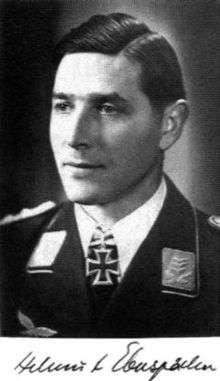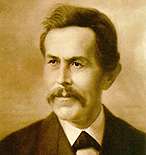Helmut Eberspächer
| Helmut Eberspächer | |
|---|---|
 | |
| Born |
18 November 1915 Tübingen |
| Died |
19 June 2011 (aged 95) Esslingen am Neckar |
| Occupation | Chairman of Eberspächer GmbH |
| Awards |
Knight's Cross of the Iron Cross Order of Merit of Baden-Württemberg |
Helmut Eberspächer (18 November 1915 – 19 June 2011) was a German businessman and chairman of Eberspächer. During World War II, he served in the Wehrmacht as a fighter pilot. A flying ace, he was awarded the Knight's Cross of the Iron Cross by Nazi Germany.
In 1950, he and his cousin Walter took over the family business, Eberspächer GmbH. He ran the business as chairman until 1988, and remained as an honorary chairman until 2005. He also served on the board of the Confederation of German Employers' Associations (BDA) and the German Automotive Industry Association. Under his leadership, Eberspächer became one of the leading automobile industry suppliers in Germany, with approximately 5,600 employees worldwide and 1.9 billion Euros in sales in 2010.[1] In 1989 he was fined for tax evasion.
Military career
Eberspächer was born on 18 November 1915 in Tübingen, Kingdom of Württemberg, German Empire. In 1934 he volunteered for military service in the Reichswehr, and served in an armoured reconnaissance battalion. In parallel to his military service he studied mechanical engineering at the University of Stuttgart. Following his graduation in 1939, he transferred to the Luftwaffe. From July 1940 to January 1943 he served with Lehrgeschwader 2 (Demonstration Wing) on both Western and Eastern Fronts. He then converted to a ground attack role, and from March 1943 served with Schnellkampfgeschwader 10 (10th Bomber Wing), flying fighter-bomber missions over southern England and anti-shipping operations in the English Channel and being appointed a squadron leader.[2]
Early on D-Day 6 June 1944, Eberspächer led four Focke-Wulf Fw 190s of 3./SKG 10 (3rd Squadron of SKG 10) over Normandy. At 05:01 they had intercepted a formation of Royal Air Force Avro Lancasters. Three were claimed as downed by Eberspächer, one of them being Lancaster ND739 of No. 97 Squadron RAF, flown by the squadron's commanding officer, W/C Jimmie Carter. His seven-man crew had earned four Distinguished Flying Crosses and three Distinguished Flying Medals. The wreckage of ND739 was located and excavated in 2012. An assortment of items were recovered including the wedding ring belonging to crew member Albert Chambers.[3][4]
Eberspächer was awarded the Knight's Cross on 24 January 1945, after 170 missions over the Western Front. He was credited with a total of seven aerial victories, including three at night.[5]
Business career

After the war, Eberspächer joined the family business, which had been founded by his grandfather, Jakob Eberspächer, in 1865 as a plumber's workshop which was known as "Glasdachfabrik-Eberspächer" (Eberspächer Roof-Glazing). He succeeded Hanns-Martin Schleyer in 1978 as president of the Landesvereinigung Baden-Württembergischer Arbeitgeberverbände (State Federation of Baden-Württemberg Employers' Associations) after Schleyer was kidnapped and murdered by the Red Army Faction on 18 October 1977. Eberspächer also supported the Internationale Bachakademie Stuttgart.[1][6]
In July 1989, in the aftermath of the Flick affair, Eberspächer was fined 140,000 DM for tax evasion. He had transferred and donated more than 300,000 DM into the accounts of the political parties Christian Democratic Union and Free Democratic Party via the "Gesellschaft zur Förderung der Wirtschaft Baden-Württemberg" (the Society for the Advancement of Economics in Baden-Württemberg) between 1972 and 1981.[7][8]
He died on 19 June 2011 in Esslingen am Neckar.[1] The Eberspächer family are heirs of his business and are ranked 264th of the 500 richest Germans in 2013, with net assets of 450 Million Euros, an increase of 100 Million Euros over the year 2012.[9]
Awards
- Ehrenpokal der Luftwaffe on 17 April 1944 as Oberleutnant and pilot[10]
- German Cross in Gold on 1 January 1945 as Hauptmann in the I./Schnellkampfgeschwader 10[11]
- Knight's Cross of the Iron Cross on 26 January 1945 as Hauptmann and Staffelkapitän of the 3./Nachtschlacht-Gruppe 20[12]
- Order of Merit of Baden-Württemberg (1979) presented on 21 April 1979 at Ludwigsburg Palace[13]
References
Citations
- 1 2 3 "Helmut Eberspächer: a socio-politically committed entrepreneur". Eberspächer. Retrieved 16 March 2013.
- ↑ Obermaier 1989, p. 105.
- ↑ "For the love of Vera: D-Day Lancaster bomber crew identified 68 years on by poignant inscription on dead airman's ring". DailyMail. London. 1 October 2012. Retrieved 16 March 2013.
- ↑ Zaloga 2011, pp. 28–29.
- ↑ Brütting 1992, p. 190.
- ↑ "Patrons". Internationale Bachakademie Stuttgart. Retrieved 24 March 2013.
- ↑ "Kleines Licht". Der Spiegel (in German). 29. 1989. Retrieved 16 March 2013.
- ↑ "Mehr Steine als Brot". Der Spiegel (in German). 17. 1989. Retrieved 16 March 2013.
- ↑ Güneri, Emel (1 February 2013). "die REICHSTEN DEUTSCHEN 2013 – Teil 3". der WISSENSCHAFTLICHE KARRIERE-BLOG! (in German). Retrieved 20 March 2013.
- ↑ Patzwall 2008, p. 70.
- ↑ Patzwall & Scherzer 2001, p. 95.
- ↑ Scherzer 2007, p. 285.
- ↑ "Verdienstorden des Landes Baden-Württemberg—Liste der Ordensträger 1975 – 2012" (PDF). Staatsministerium Baden-Württemberg (in German). p. 12. Retrieved 19 March 2013.
Bibliography
- Brütting, Georg (1992) [1976]. Das waren die deutschen Stuka-Asse 1939 – 1945 [These were the German Stuka Aces 1939 – 1945] (in German) (7th ed.). Stuttgart, Germany: Motorbuch. ISBN 978-3-87943-433-6.
- Obermaier, Ernst (1989). Die Ritterkreuzträger der Luftwaffe Jagdflieger 1939 – 1945 [The Knight's Cross Bearers of the Luftwaffe Fighter Force 1939 – 1945] (in German). Mainz, Germany: Verlag Dieter Hoffmann. ISBN 978-3-87341-065-7.
- Patzwall, Klaus D.; Scherzer, Veit (2001). Das Deutsche Kreuz 1941 – 1945 Geschichte und Inhaber Band II [The German Cross 1941 – 1945 History and Recipients Volume 2] (in German). Norderstedt, Germany: Verlag Klaus D. Patzwall. ISBN 978-3-931533-45-8.
- Patzwall, Klaus D. (2008). Der Ehrenpokal für besondere Leistung im Luftkrieg [The Honor Goblet for Outstanding Achievement in the Air War] (in German). Norderstedt, Germany: Verlag Klaus D. Patzwall. ISBN 978-3-931533-08-3.
- Scherzer, Veit (2007). Die Ritterkreuzträger 1939–1945 Die Inhaber des Ritterkreuzes des Eisernen Kreuzes 1939 von Heer, Luftwaffe, Kriegsmarine, Waffen-SS, Volkssturm sowie mit Deutschland verbündeter Streitkräfte nach den Unterlagen des Bundesarchives [The Knight's Cross Bearers 1939–1945 The Holders of the Knight's Cross of the Iron Cross 1939 by Army, Air Force, Navy, Waffen-SS, Volkssturm and Allied Forces with Germany According to the Documents of the Federal Archives] (in German). Jena, Germany: Scherzers Militaer-Verlag. ISBN 978-3-938845-17-2.
- Spick, Mike (1996). Luftwaffe Fighter Aces. New York: Ivy Books. ISBN 978-0-8041-1696-1.
- Zaloga, Steven J. (2011). The Most Daring Raid of World War II: D-Day—Pointe-Du-Hoc. New York: The Rosen Publishing Group. ISBN 978-1-4488-1867-9.
External links
- "Parteispenden: Mal die Matratze hochheben". Der Spiegel (in German). 38. 1985. Retrieved 16 March 2013.
- "Weit über das Maß". Der Spiegel (in German). 48. 1987. Retrieved 16 March 2013.
- "Mehr Steine als Brot". Der Spiegel (in German). 17. 1989. Retrieved 16 March 2013.
- "Schelle um den Hals". Der Spiegel (in German). 23. 1989. Retrieved 16 March 2013.
- "Kleines Licht". Der Spiegel (in German). 29. 1989. Retrieved 16 March 2013.
- "Tätige Spender-Reue". Der Spiegel (in German). 30. 1989. Retrieved 16 March 2013.
- "So dappig". Der Spiegel (in German). 14. 1990. Retrieved 16 March 2013.